Shihao Wang
DP$^2$O-SR: Direct Perceptual Preference Optimization for Real-World Image Super-Resolution
Oct 21, 2025Abstract:Benefiting from pre-trained text-to-image (T2I) diffusion models, real-world image super-resolution (Real-ISR) methods can synthesize rich and realistic details. However, due to the inherent stochasticity of T2I models, different noise inputs often lead to outputs with varying perceptual quality. Although this randomness is sometimes seen as a limitation, it also introduces a wider perceptual quality range, which can be exploited to improve Real-ISR performance. To this end, we introduce Direct Perceptual Preference Optimization for Real-ISR (DP$^2$O-SR), a framework that aligns generative models with perceptual preferences without requiring costly human annotations. We construct a hybrid reward signal by combining full-reference and no-reference image quality assessment (IQA) models trained on large-scale human preference datasets. This reward encourages both structural fidelity and natural appearance. To better utilize perceptual diversity, we move beyond the standard best-vs-worst selection and construct multiple preference pairs from outputs of the same model. Our analysis reveals that the optimal selection ratio depends on model capacity: smaller models benefit from broader coverage, while larger models respond better to stronger contrast in supervision. Furthermore, we propose hierarchical preference optimization, which adaptively weights training pairs based on intra-group reward gaps and inter-group diversity, enabling more efficient and stable learning. Extensive experiments across both diffusion- and flow-based T2I backbones demonstrate that DP$^2$O-SR significantly improves perceptual quality and generalizes well to real-world benchmarks.
VideoITG: Multimodal Video Understanding with Instructed Temporal Grounding
Jul 17, 2025Abstract:Recent studies have revealed that selecting informative and relevant video frames can significantly improve the performance of Video Large Language Models (Video-LLMs). Current methods, such as reducing inter-frame redundancy, employing separate models for image-text relevance assessment, or utilizing temporal video grounding for event localization, substantially adopt unsupervised learning paradigms, whereas they struggle to address the complex scenarios in long video understanding. We propose Instructed Temporal Grounding for Videos (VideoITG), featuring customized frame sampling aligned with user instructions. The core of VideoITG is the VidThinker pipeline, an automated annotation framework that explicitly mimics the human annotation process. First, it generates detailed clip-level captions conditioned on the instruction; then, it retrieves relevant video segments through instruction-guided reasoning; finally, it performs fine-grained frame selection to pinpoint the most informative visual evidence. Leveraging VidThinker, we construct the VideoITG-40K dataset, containing 40K videos and 500K instructed temporal grounding annotations. We then design a plug-and-play VideoITG model, which takes advantage of visual language alignment and reasoning capabilities of Video-LLMs, for effective frame selection in a discriminative manner. Coupled with Video-LLMs, VideoITG achieves consistent performance improvements across multiple multimodal video understanding benchmarks, showing its superiority and great potentials for video understanding.
Eagle 2.5: Boosting Long-Context Post-Training for Frontier Vision-Language Models
Apr 21, 2025Abstract:We introduce Eagle 2.5, a family of frontier vision-language models (VLMs) for long-context multimodal learning. Our work addresses the challenges in long video comprehension and high-resolution image understanding, introducing a generalist framework for both tasks. The proposed training framework incorporates Automatic Degrade Sampling and Image Area Preservation, two techniques that preserve contextual integrity and visual details. The framework also includes numerous efficiency optimizations in the pipeline for long-context data training. Finally, we propose Eagle-Video-110K, a novel dataset that integrates both story-level and clip-level annotations, facilitating long-video understanding. Eagle 2.5 demonstrates substantial improvements on long-context multimodal benchmarks, providing a robust solution to the limitations of existing VLMs. Notably, our best model Eagle 2.5-8B achieves 72.4% on Video-MME with 512 input frames, matching the results of top-tier commercial model such as GPT-4o and large-scale open-source models like Qwen2.5-VL-72B and InternVL2.5-78B.
The Tenth NTIRE 2025 Efficient Super-Resolution Challenge Report
Apr 14, 2025Abstract:This paper presents a comprehensive review of the NTIRE 2025 Challenge on Single-Image Efficient Super-Resolution (ESR). The challenge aimed to advance the development of deep models that optimize key computational metrics, i.e., runtime, parameters, and FLOPs, while achieving a PSNR of at least 26.90 dB on the $\operatorname{DIV2K\_LSDIR\_valid}$ dataset and 26.99 dB on the $\operatorname{DIV2K\_LSDIR\_test}$ dataset. A robust participation saw \textbf{244} registered entrants, with \textbf{43} teams submitting valid entries. This report meticulously analyzes these methods and results, emphasizing groundbreaking advancements in state-of-the-art single-image ESR techniques. The analysis highlights innovative approaches and establishes benchmarks for future research in the field.
OmniDrive: A Holistic Vision-Language Dataset for Autonomous Driving with Counterfactual Reasoning
Apr 06, 2025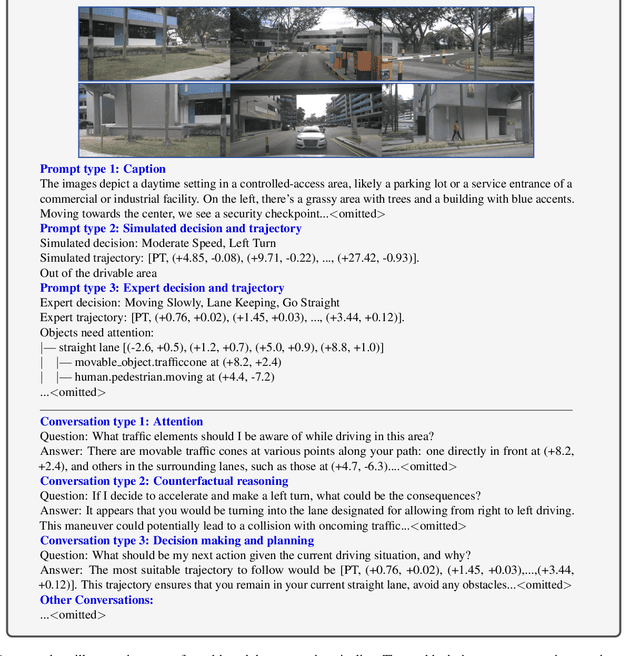

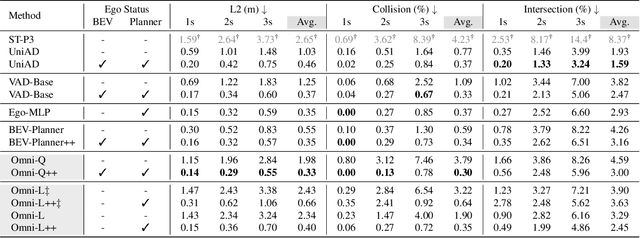
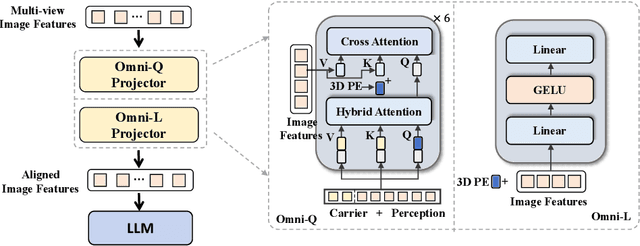
Abstract:The advances in vision-language models (VLMs) have led to a growing interest in autonomous driving to leverage their strong reasoning capabilities. However, extending these capabilities from 2D to full 3D understanding is crucial for real-world applications. To address this challenge, we propose OmniDrive, a holistic vision-language dataset that aligns agent models with 3D driving tasks through counterfactual reasoning. This approach enhances decision-making by evaluating potential scenarios and their outcomes, similar to human drivers considering alternative actions. Our counterfactual-based synthetic data annotation process generates large-scale, high-quality datasets, providing denser supervision signals that bridge planning trajectories and language-based reasoning. Futher, we explore two advanced OmniDrive-Agent frameworks, namely Omni-L and Omni-Q, to assess the importance of vision-language alignment versus 3D perception, revealing critical insights into designing effective LLM-agents. Significant improvements on the DriveLM Q\&A benchmark and nuScenes open-loop planning demonstrate the effectiveness of our dataset and methods.
Slow-Fast Architecture for Video Multi-Modal Large Language Models
Apr 02, 2025Abstract:Balancing temporal resolution and spatial detail under limited compute budget remains a key challenge for video-based multi-modal large language models (MLLMs). Existing methods typically compress video representations using predefined rules before feeding them into the LLM, resulting in irreversible information loss and often ignoring input instructions. To address this, we propose a novel slow-fast architecture that naturally circumvents this trade-off, enabling the use of more input frames while preserving spatial details. Inspired by how humans first skim a video before focusing on relevant parts, our slow-fast design employs a dual-token strategy: 1) "fast" visual tokens -- a compact set of compressed video features -- are fed into the LLM alongside text embeddings to provide a quick overview; 2) "slow" visual tokens -- uncompressed video features -- are cross-attended by text embeddings through specially designed hybrid decoder layers, enabling instruction-aware extraction of relevant visual details with linear complexity. We conduct systematic exploration to optimize both the overall architecture and key components. Experiments show that our model significantly outperforms self-attention-only baselines, extending the input capacity from 16 to 128 frames with just a 3% increase in computation, and achieving a 16% average performance improvement across five video understanding benchmarks. Our 7B model achieves state-of-the-art performance among models of similar size. Furthermore, our slow-fast architecture is a plug-and-play design that can be integrated into other video MLLMs to improve efficiency and scalability.
InsViE-1M: Effective Instruction-based Video Editing with Elaborate Dataset Construction
Mar 26, 2025

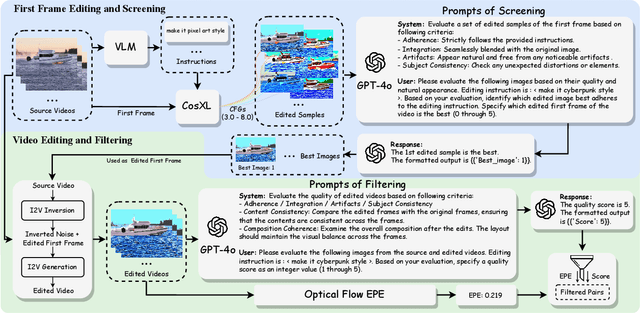

Abstract:Instruction-based video editing allows effective and interactive editing of videos using only instructions without extra inputs such as masks or attributes. However, collecting high-quality training triplets (source video, edited video, instruction) is a challenging task. Existing datasets mostly consist of low-resolution, short duration, and limited amount of source videos with unsatisfactory editing quality, limiting the performance of trained editing models. In this work, we present a high-quality Instruction-based Video Editing dataset with 1M triplets, namely InsViE-1M. We first curate high-resolution and high-quality source videos and images, then design an effective editing-filtering pipeline to construct high-quality editing triplets for model training. For a source video, we generate multiple edited samples of its first frame with different intensities of classifier-free guidance, which are automatically filtered by GPT-4o with carefully crafted guidelines. The edited first frame is propagated to subsequent frames to produce the edited video, followed by another round of filtering for frame quality and motion evaluation. We also generate and filter a variety of video editing triplets from high-quality images. With the InsViE-1M dataset, we propose a multi-stage learning strategy to train our InsViE model, progressively enhancing its instruction following and editing ability. Extensive experiments demonstrate the advantages of our InsViE-1M dataset and the trained model over state-of-the-art works. Codes are available at InsViE.
Hydra-NeXt: Robust Closed-Loop Driving with Open-Loop Training
Mar 15, 2025Abstract:End-to-end autonomous driving research currently faces a critical challenge in bridging the gap between open-loop training and closed-loop deployment. Current approaches are trained to predict trajectories in an open-loop environment, which struggle with quick reactions to other agents in closed-loop environments and risk generating kinematically infeasible plans due to the gap between open-loop training and closed-loop driving. In this paper, we introduce Hydra-NeXt, a novel multi-branch planning framework that unifies trajectory prediction, control prediction, and a trajectory refinement network in one model. Unlike current open-loop trajectory prediction models that only handle general-case planning, Hydra-NeXt further utilizes a control decoder to focus on short-term actions, which enables faster responses to dynamic situations and reactive agents. Moreover, we propose the Trajectory Refinement module to augment and refine the planning decisions by effectively adhering to kinematic constraints in closed-loop environments. This unified approach bridges the gap between open-loop training and closed-loop driving, demonstrating superior performance of 65.89 Driving Score (DS) and 48.20% Success Rate (SR) on the Bench2Drive dataset without relying on external experts for data collection. Hydra-NeXt surpasses the previous state-of-the-art by 22.98 DS and 17.49 SR, marking a significant advancement in autonomous driving. Code will be available at https://github.com/woxihuanjiangguo/Hydra-NeXt.
L3TC: Leveraging RWKV for Learned Lossless Low-Complexity Text Compression
Dec 24, 2024
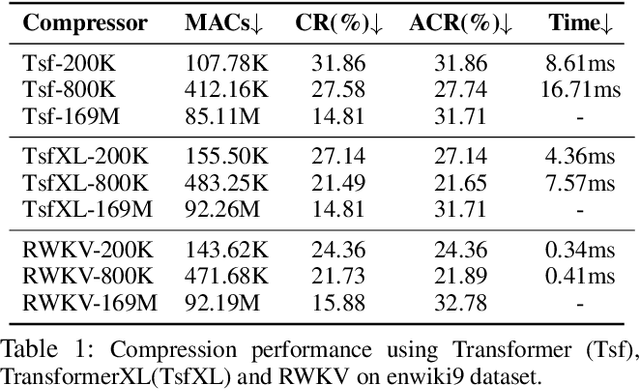


Abstract:Learning-based probabilistic models can be combined with an entropy coder for data compression. However, due to the high complexity of learning-based models, their practical application as text compressors has been largely overlooked. To address this issue, our work focuses on a low-complexity design while maintaining compression performance. We introduce a novel Learned Lossless Low-complexity Text Compression method (L3TC). Specifically, we conduct extensive experiments demonstrating that RWKV models achieve the fastest decoding speed with a moderate compression ratio, making it the most suitable backbone for our method. Second, we propose an outlier-aware tokenizer that uses a limited vocabulary to cover frequent tokens while allowing outliers to bypass the prediction and encoding. Third, we propose a novel high-rank reparameterization strategy that enhances the learning capability during training without increasing complexity during inference. Experimental results validate that our method achieves 48% bit saving compared to gzip compressor. Besides, L3TC offers compression performance comparable to other learned compressors, with a 50x reduction in model parameters. More importantly, L3TC is the fastest among all learned compressors, providing real-time decoding speeds up to megabytes per second. Our code is available at https://github.com/alipay/L3TC-leveraging-rwkv-for-learned-lossless-low-complexity-text-compression.git.
Transformer-based toxin-protein interaction analysis prioritizes airborne particulate matter components with potential adverse health effects
Dec 21, 2024Abstract:Air pollution, particularly airborne particulate matter (PM), poses a significant threat to public health globally. It is crucial to comprehend the association between PM-associated toxic components and their cellular targets in humans to understand the mechanisms by which air pollution impacts health and to establish causal relationships between air pollution and public health consequences. Although many studies have explored the impact of PM on human health, the understanding of the association between toxins and the associated targets remain limited. Leveraging cutting-edge deep learning technologies, we developed tipFormer (toxin-protein interaction prediction based on transformer), a novel deep-learning tool for identifying toxic components capable of penetrating human cells and instigating pathogenic biological activities and signaling cascades. Experimental results show that tipFormer effectively captures interactions between proteins and toxic components. It incorporates dual pre-trained language models to encode protein sequences and chemicals. It employs a convolutional encoder to assimilate the sequential attributes of proteins and chemicals. It then introduces a learning module with a cross-attention mechanism to decode and elucidate the multifaceted interactions pivotal for the hotspots binding proteins and chemicals. Experimental results show that tipFormer effectively captures interactions between proteins and toxic components. This approach offers significant value to air quality and toxicology researchers by allowing high-throughput identification and prioritization of hazards. It supports more targeted laboratory studies and field measurements, ultimately enhancing our understanding of how air pollution impacts human health.
 Add to Chrome
Add to Chrome Add to Firefox
Add to Firefox Add to Edge
Add to Edge